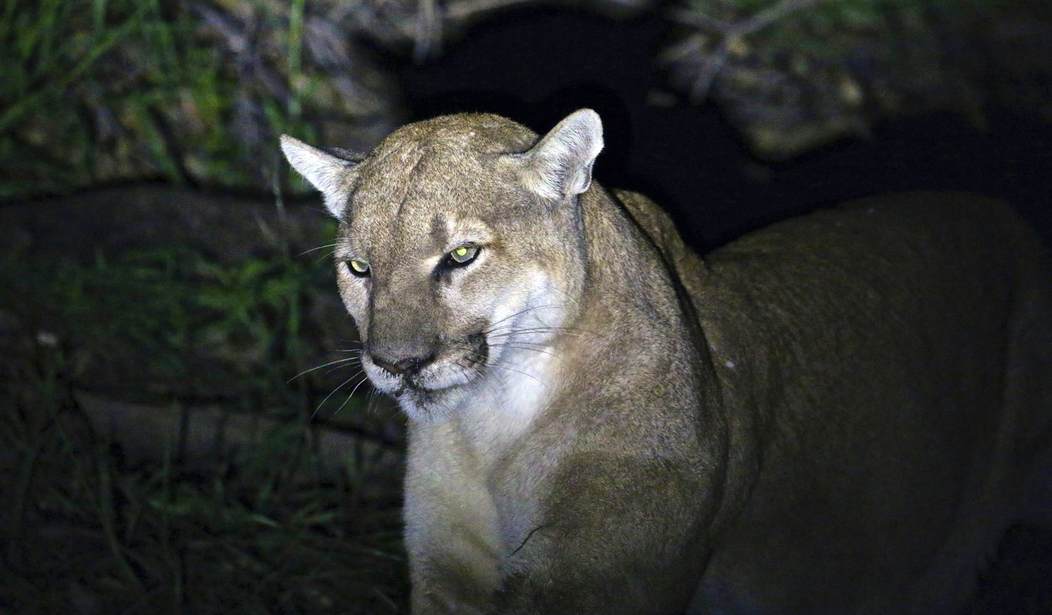Some years ago, probably around 1995, if memory serves, a buddy of mine was indulging in one of his outdoor hobbies: collecting shed elk and deer antlers. On one fateful day, he was walking back to his truck down a hiking trail in the Flattops Range just as the sun was drawing low in the sky and shadows were getting long. He had a five-point elk antler in one hand and a folding knife in his pocket.
Suddenly, all the hair on the back of his neck stood up. "I knew something was watching me," he told me later. When he turned and looked behind him, there, on the trail, maybe thirty feet away, was a big, full-grown tom mountain lion, crouched, its tail lashing back and forth.
My friend grabbed his folding knife, opened it, and began waving the elk antler over his head and shouting. Found out, the big tom considered him for a moment, then stood up and walked away. My buddy never again went into the mountains, especially alone, without his .45 on his belt.
Mountain lions are formidable beasts. A full-grown tom like the one that threatened my buddy may weigh 200 pounds but can easily kill an elk that weighs three times as much — I've found elk that were killed by lions, and the marks are very obvious. Lions kill by biting at the base of the skull and severing the spinal cord, and their jaws are perfectly adapted to bite the neck of cervids, especially deer. A human cervical vertebrae, I would point out, is about the same diameter as that of a deer. But lions generally give people a wide berth because they perceive people as dangerous. Now, a Colorado activist group wants to change that.
An advocacy committee called CATs, or Cats Aren’t Trophies, is backing ballot initiative 91 to ban trophy hunting of mountain lions as well as fur trapping of bobcats, explained Samantha Miller, a Grand Lake resident and CATs campaign manager.
“What we are seeking is a paradigm shift so that we are managing for healthy ecosystems,” Miller said. “To me, what’s really alarming is we are continuing to manage mountain lions to be hunted and not for ecosystem health. If we are looking at the big picture, which is health of ecosystems across the state, mountain lion trophy hunting is not needed to manage the population, and lions play an essential role in the ecosystem.”
However, officials and researchers at CPW, which has managed mountain lion numbers since 1965, say the population growth of humans in Colorado does not allow animals to be managed solely based on natural ecosystems. CPW game species are managed according to what some experts refer to as a “social carrying capacity.”
“We are tasked with managing (mountain lions) due to challenges brought on by the nearly 6 million people who now call Colorado home,” Mark Vieira, CPW carnivore and furbearer program manager, told CPW Commissioners during their January meeting.
Across Colorado during the 2022-23 season, 2,599 hunters killed 502 mountain lions, including 298 males and 204 females. For the nine previous seasons, hunters have killed 442-526 mountain lions each year.
Vieira told commissioners the mountain lion population in Colorado — roughly estimated between 3,800 and 4,400 adult lions — represents a conservation success story compared to pre-1965. He said big cats are managed similar to other big game species, and “mountain lions are not threatened or endangered in any way.”
In other words, the wildlife biologists who work for the state of Colorado, whose job it is to manage wildlife, whose expertise we supposedly rely on, are against this, but the activists want to go ahead anyway. So much for "believe the science."
See Related: Colorado Eyes Reintroduction of Wolverines
These animals are in no way endangered. Hunting them is a real challenge; just for fun, my hunting partner and I once followed the tracks of a big tom through fresh snow for about a mile before he sensed us on his trail and ran, and we never laid eyes on him. In the thirty years I lived in Colorado, during which time I spent a lot of time hunting, fishing, and wandering around in the mountains, I only ever saw two lions, both at a distance. But they can be dangerous — only last year, a lion was killed for attacking an 11-year-old child, who fortunately escaped serious injury. In 1999, a three-year-old boy disappeared near Fort Collins, and his remains were found much later — the victim of a lion. And he wasn't the only victim of a Colorado lion.
But an 18-year-old man was killed by a mountain lion near Idaho Springs in 1991, and a 10-year-old boy was killed by a lion in 1997 in nearby Rocky Mountain National Park. Wildlife experts said it wouldn’t take much for a mountain lion to carry a 3-year-old boy off the trail.
This is a bad idea. When apex predators learn that humans aren't dangerous, they begin to view them as food. Mountain lions are very effective predators; where wolves have a hunt-kill success rate of about 15 percent, lions come in at over 80 percent.
See Related: Q: When You Die, Will Your Cat Eat Your Face? A: Yes.
Back to my buddy and his encounter: Later that year, he got a lion tag from the Division of Wildlife (as Colorado Parks & Wildlife was then known) and went back up into the Flattops looking for that cat. Its skin now adorns his living room wall. Maybe it would have never again threatened another human. Then again, maybe it would have.
Managing wildlife — especially predators — by ballot initiative is a bad idea, especially when the voters in favor are overwhelmingly urban liberals who will never be within a mile of the animals in question. This initiative should, in a sane world, go down to defeat; but these days, in Colorado, it will likely pass.














Join the conversation as a VIP Member